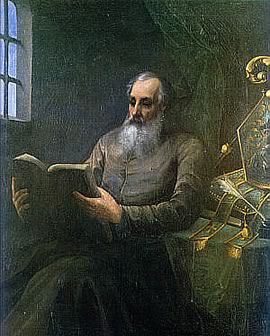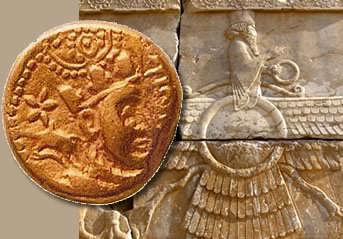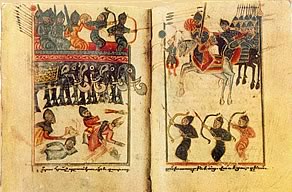The Golden Age
St. Mesrob and the Golden Age of Armenia
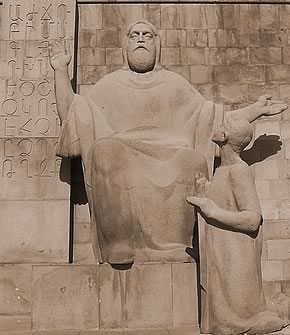 Statue of St. Mesrop at the Matenadaran Institute of Ancient Manuscripts in Yerevan, Armenia. The letters in their original shapes can be seen on the stone plaque.
Statue of St. Mesrop at the Matenadaran Institute of Ancient Manuscripts in Yerevan, Armenia. The letters in their original shapes can be seen on the stone plaque.
The Armenian Kingdom fell into decay, but Christianity in Armenia strengthened considerably. At that time the necessity emerged to revive the lost Armenian alphabet. The Masses in Armenian churches were sung in Greek, the Royal Court and nobility spoke Greek and Parthian, priesthood, schools and different educational institutions widely used Greek and Syrian. Therefore, the recreation of the alphabet became vital to oppose the possible assimilation.
King Vramshapouh and Catholicos Sahak Partev assigned the task to Mesrob Mashtots, a genius scholar monk. For several years, he traveled throughout Greater and Lesser Armenias and Mediterranean world in quest for the lost scriptures. In Edessa, he finds some of the scrolls in old Armenian, and after carefully reviewing them and exploring the possibilities, he recreates the Armenian alphabet in 405.
In 425, the Bible was translated into the Armenian language from the authentic copies of the Bible brought from Constantinople and Edessa. The Armenian translation is the fifth known translation of the Bible. Earlier, the Bible was only translated into the Syriac, the Latin, the Coptic and the Abyssinian languages. Some specialists estimate this translation, performed by St.Mesrob and his disciples, as the best Bible translation ever. The French linguists of the 19th century termed it as the “Queen of translations”. St.Mesrob, later elevated into sainthood, is also known as the author of the actual Georgian alphabet. He also invented an alphabet for the large tribe of Gargareans, that inhabited Aghuank.
Paradoxically, the 5th century, marked by serious political losses, became the Golden Age of the Armenian literature. The works of Faustus the Byzantine, Moses of Khorene, Eliseus , Koriun, Lazarus Barbedzi, Eznik of Kolb, David the Invincible, and others, may be considered milestones of historiography and philosophy.
St. Vardan and the first war for the Christian faith
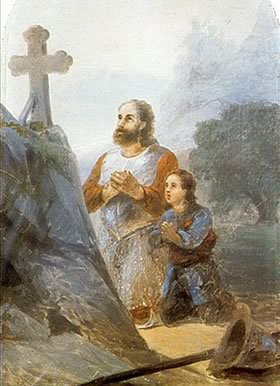 St.Vardan before the battle of Avarayr, fragment of 1892 painting by Ivan Ayvazovsky
St.Vardan before the battle of Avarayr, fragment of 1892 painting by Ivan Ayvazovsky
Meanwhile, Armenia lost independence. Over the next 200 years the eastern provinces were ruled by the Persian marzpans. A number of insurrections took place during that period. The most famous among them was the so-called Vardanank, War of St.Vardan in 451, described in details by Eliseus and Lazarus Barbedzi. The Persian King Yazdegerd II tried to put an end to Christianity in Armenia, and to disseminate the doctrine of Zoroaster. Armenians revolted when the numerous Persian priests were sent to Armenia to build temples and conduct fire worship.
On May 6, 451 a horrifically bloody battle took place in the Avarayr place. 66 thousand Armenians heroically fought the overwhelmingly superior Persian troops. Most of the Armenian lords including St.Vardan fell in battle, but Armenia undoubtedly won a great moral victory. Over 60 thousand of Persian soldiers were killed, and Yazdegerd’s hopes were dashed. That was the first known war for Christian faith in history.
Vahan Mamikonean
30 years later a new resurrection took place, headed by Prince Vahan Mamikonean, St.Vardan’s nephew. This commander fought the Persian king Firuz II with changeable success. Firuz’s successor was a moderate ruler conceding the freedom of religion. Vahan was granted the title of marzpan. Another offspring of Mamikonean family, known as Red Vardan, rose against Persians in the middle of the next century. He captured the city of Dvin, the old Armenian capital. But soon the rising was put down, and Vardan made his escape to Greece.
In 551 Moses , the Armenian Catholicos set a new Armenian calendar from AD 551.


